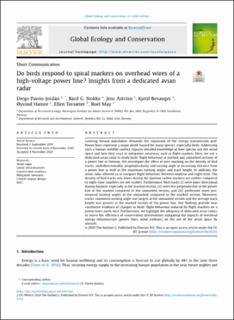Do birds respond to spiral markers on overhead wires of a high-voltage power line? Insights from a dedicated avian radar
Pavòn-Jordàn, Diego; Stokke, Bård Gunnar; Åström, Jens; Bevanger, Kjetil Modolv; Hamre, Øyvind; Torsæter, Ellen; May, Roelof Frans
Peer reviewed, Journal article
Published version

Åpne
Permanent lenke
https://hdl.handle.net/11250/2724510Utgivelsesdato
2020Metadata
Vis full innførselSamlinger
- Publikasjoner fra CRIStin - NINA [2364]
- Scientific publications [1392]
Originalversjon
https://doi.org/10.1016/j.gecco.2020.e01363Sammendrag
Growing human population demands the expansion of the energy transmission grid. Power lines represent a major death hazard for many species, especially birds. Addressing such a human-wildlife conflict requires detailed knowledge of how species use the aerial space and how they react to mitigation measures, such as flight markers. Here, we use a dedicated avian radar to study birds’ flight behaviour at marked and unmarked sections of a power line in Norway. We investigate the effect of wire marking on the density of bird tracks, multidirectionality, perpendicularity and turning angle at increasing distance from a power line as well as the maximum turning angles and track height. In addition, the avian radar allowed us to compare flight behaviour between daytime and night-time. The density of bird tracks was lower during the daytime (when markers are visible) compared to night-time (markers are not visible). Furthermore, bird tracks (i) were more directional during daytime, especially at the marked section, (ii) were less perpendicular to the power line at the marked compared to the unmarked section, and (iii) performed more pronounced turning angles at the unmarked compared to the marked section. Moreover, tracks’ maximum turning angle was largest at the unmarked section and the average track height was greater at the marked section of the power line. Our findings provide new correlative evidence of changes in birds’ flight behaviour induced by flight markers on a power line’s earth wire. Furthermore, we highlight the adequacy of dedicated avian radars to assess the efficiency of conservation interventions mitigating the impacts of overhead energy infrastructure (power lines, wind turbines) on the use of the aerial space by animals.
